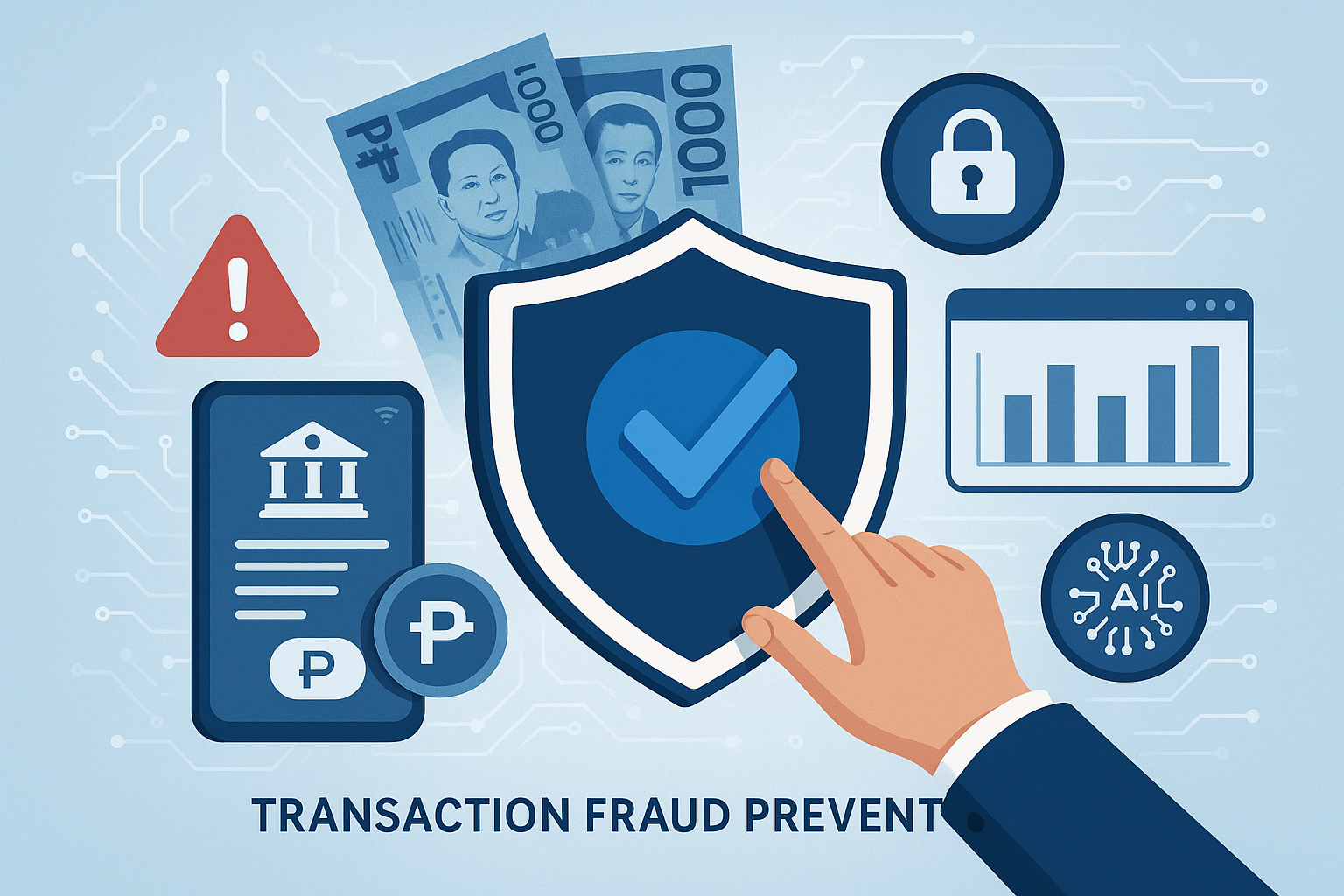Beyond the Numbers: A Modern Guide to Detecting and Preventing Financial Fraud
.svg)
Financial fraud is escalating into a global crisis, costing businesses and consumers billions every year.
According to the Association of Certified Fraud Examiners (ACFE), businesses lose an estimated 5% of their annual revenue to fraud—translating into staggering global losses that impact profitability, investor trust, and long-term stability.
Even individuals aren’t safe. Recent data from the Federal Trade Commission (FTC) revealed that consumers reported nearly $8.8 billion in fraud losses in 2022, a sharp 30% increase from the previous year. From phishing scams to identity theft, fraud is surging at every level—affecting corporations, banks, and everyday people alike.
In this article, we’ll break down the fundamentals of financial fraud, examine its impact on organisations, explore key red flags to watch for, and highlight how advanced AML fraud detection strategies can help financial institutions stay ahead of these ever-evolving threats.
Understanding the Landscape of Financial Crime and the Role of AML Fraud Detection
The financial crime landscape is increasingly complex, driven by evolving technologies, global financial connectivity, and increasingly sophisticated criminal networks. For financial institutions, staying ahead of this rapidly changing environment is not just about compliance—it’s a matter of survival.
Fraudsters today leverage advanced tools and global networks to exploit vulnerabilities across digital channels. As a result, effective AML fraud detection strategies must adapt to a broader and more intricate threat landscape.
Key Challenges in Financial Crime Today:
- Identity theft and account takeovers
- Cyberattacks and large-scale data breaches
- Terrorist financing and politically exposed transactions
- Layered, cross-border money laundering schemes
Complicating matters further is the growing weight of global regulatory expectations. Financial institutions must not only meet anti-money laundering (AML) and counter-terrorism financing (CFT) obligations, but also evolve quickly to remain compliant with new rules, risk typologies, and jurisdictions.
The actors behind financial crime are often part of highly coordinated, well-funded networks. Detecting such activity goes beyond flagging individual transactions—it requires uncovering patterns, anomalies, and behaviours using advanced AML fraud detection systems powered by AI and machine learning.
At the same time, innovation in fintech, payments, and cross-border services is introducing new fraud vulnerabilities. Staying ahead of these emerging threats means financial institutions must embrace both technological agility and a deep understanding of criminal methodologies.
In the next section, we'll explore how technology is transforming the fight against financial crime—and how the next generation of AML fraud detection tools is reshaping compliance as we know it.

What Is Financial Fraud? Common Types You Need to Know
Financial fraud refers to deceptive activities carried out for unlawful financial gain—often resulting in significant losses for individuals, corporations, and financial institutions. These fraudulent acts range from small-scale identity theft to elaborate investment scams, all of which undermine trust in the financial system and call for robust AML fraud detection measures.
Here are some of the most common types of financial fraud today:
- Identity Theft: Identity theft occurs when a fraudster steals someone’s personal information, such as their name, date of birth, Social Security number, or banking credentials, to impersonate them. Criminals may use this stolen identity to open fraudulent accounts, secure loans, or make unauthorised transactions.
- Credit Card Fraud: This form of fraud involves the unauthorised use of someone’s credit card or card details to make purchases or withdraw money. It’s one of the most common types of financial fraud in the digital era, especially in card-not-present (CNP) environments like e-commerce platforms.
- Ponzi Schemes: A Ponzi scheme is a fraudulent investment scam that promises high returns with little or no risk. Early investors may receive payouts—funded not by profits but by money from new investors. Eventually, the scheme collapses when new funds dry up, leaving later investors with heavy losses.
As fraud types grow in sophistication, financial institutions must evolve their detection strategies. A strong AML fraud detection system is built not only to catch known fraud types but also to adapt to new and emerging typologies through machine learning and expert-driven scenario modelling.
{{cta-first}}
Real-Life Examples of Financial Fraud
Enron Scandal (2001):
The Enron scandal is one of the most infamous examples of financial fraud in recent history. Enron, once considered a powerhouse in the energy sector, engaged in accounting practices that inflated the company's profits and hid its debts. Executives created off-the-books partnerships to conceal losses and boost stock prices artificially. When the truth came to light, Enron filed for bankruptcy in 2001, resulting in significant financial losses for investors and employees.
Bernie Madoff's Ponzi Scheme (2008):
Bernie Madoff orchestrated one of the largest Ponzi schemes in history. Operating for several decades, Madoff attracted investors with promises of consistent, high returns. However, instead of investing the funds, he used new investors' money to pay returns to earlier investors. This fraudulent scheme unravelled in 2008 during the global financial crisis when investors sought to withdraw their funds. Madoff admitted to the fraud, and the fallout led to substantial financial losses for thousands of investors. Madoff was convicted and sentenced to 150 years in prison.
How does it affect financial organisations?
Financial fraud has a profound and far-reaching impact on the organisations ensnared in its web. The repercussions extend beyond mere monetary losses, touching upon various aspects that can severely disrupt the stability and reputation of financial institutions.
1. Widespread Financial Loss:
The most immediate and tangible consequence of financial fraud for organisations is the financial hit they take. Whether it's through embezzlement, deceptive accounting practices, or other fraudulent activities, these illicit manoeuvres can result in substantial monetary losses. These losses can directly affect the bottom line, compromising the financial health and sustainability of the organisation.
2. Loss of Trust and Confidence in Their Services:
Financial institutions thrive on trust. When fraud is exposed, it erodes the trust and confidence that clients, investors, and the general public have in the institution. Customers may question the security of their accounts and investments, leading to a loss of faith in the institution's ability to safeguard their financial interests. Rebuilding this trust becomes a challenging and time-consuming process.
3. Government Investigations and Punitive Actions:
Financial fraud often triggers government investigations and regulatory scrutiny. Authorities step in to assess the extent of the wrongdoing and to ensure compliance with financial regulations. The fallout can include hefty fines, legal actions, and regulatory sanctions against the organisation and its key figures. These punitive measures not only carry financial consequences but also tarnish the institution's standing in the eyes of both clients and the broader financial community.
In some cases, the damage isn't just financial; it's reputational. Financial organisations rely heavily on their reputation for stability, reliability, and integrity. When fraud comes to light, it casts a dark shadow over these pillars, making it challenging to regain the trust of clients and stakeholders. The aftermath of financial fraud, therefore, involves a complex process of financial recovery, regulatory compliance, and rebuilding the shattered trust that is essential for the long-term success of any financial institution.
Red Flags of Financial Fraud
Identifying red flags is crucial for detecting and preventing fraud. Unusual transaction patterns, sudden changes in account activity, and discrepancies in financial records are key indicators. Awareness of these signs is essential for timely intervention.
1. Unusual Transaction Patterns:
From a business standpoint, unexpected spikes or drops in transaction volumes can be a red flag. For example, an unusual surge in transactions within a short time frame or irregularities in the size and frequency of transactions could signal potential fraudulent activity. This is particularly crucial for businesses that deal with a high volume of transactions, such as e-commerce platforms or financial institutions, as detecting anomalies in the transaction flow becomes essential.
2. Sudden Changes in Account Activity:
Businesses often maintain multiple accounts for various purposes, and sudden changes in the activity of these accounts can raise suspicions. For instance, if an account that typically sees a steady flow of transactions suddenly experiences a surge in withdrawals or transfers, it could be indicative of unauthorised or fraudulent activity. Timely monitoring of account activities becomes vital to identify and address such abrupt changes before they escalate into substantial financial losses.
3. Discrepancies in Financial Records:
Businesses rely on accurate financial records for decision-making and reporting. Discrepancies in these records, such as unexplained variances between reported and actual figures, can be a red flag. For instance, unexpected adjustments to financial statements or inconsistencies in accounting entries may suggest fraudulent attempts to manipulate financial data. Businesses must maintain robust internal controls and conduct regular audits to promptly detect and rectify any irregularities in their financial records.
Fraud Prevention Measures
Implementing robust prevention measures is vital for safeguarding against financial fraud. This includes strict authentication protocols, employee training programs, and the use of advanced security technologies to secure sensitive data.
1. Strict Authentication Protocols:
Establishing stringent authentication protocols is the first line of defence against unauthorised access and fraudulent activities. This involves implementing multi-factor authentication (MFA) mechanisms, such as combining passwords with biometric verification or token-based systems. By requiring multiple forms of verification, businesses add layers of security, making it more challenging for fraudsters to gain unauthorised access to sensitive accounts or systems.
2. Employee Training Programs:
Employees are often the frontline defence against fraud, and comprehensive training programs are instrumental in arming them with the knowledge and skills needed to identify and prevent fraudulent activities. Training should cover recognising phishing attempts, understanding social engineering tactics, and promoting a culture of security awareness. When employees are well-informed and vigilant, they become an invaluable asset in the organisation's efforts to combat fraud.
3. Use of Advanced Security Technologies:
Leveraging cutting-edge security technologies is imperative in the fight against financial fraud. This includes the implementation of artificial intelligence (AI) and machine learning (ML) algorithms that can analyse vast datasets in real-time, identifying patterns and anomalies indicative of fraudulent behaviour. Advanced encryption techniques ensure the secure transmission of sensitive data, protecting it from interception or unauthorised access.
4. Regular Security Audits and Assessments:
Conducting regular security audits and assessments is a proactive approach to identifying vulnerabilities and weaknesses in the organisation's systems and processes. This involves evaluating the effectiveness of existing security measures, conducting penetration testing, and staying abreast of the latest security threats. By regularly assessing the security landscape, businesses can adapt their fraud prevention strategies to address emerging risks.
5. Vendor and Third-Party Risk Management:
Businesses often collaborate with external vendors and third parties, and these partnerships can introduce additional risks. Implementing a robust vendor and third-party risk management program involves thoroughly vetting and monitoring the security practices of external entities. Clear contractual agreements should outline security expectations and establish accountability for maintaining a secure environment.
6. Data Encryption and Secure Storage Practices:
Protecting sensitive data is a cornerstone of fraud prevention. Implementing robust data encryption practices ensures that even if unauthorised access occurs, the stolen data remains unreadable. Secure storage practices involve limiting access to sensitive information on a need-to-know basis and employing secure, encrypted databases to safeguard against data breaches.
Fraud Detection Techniques
Financial institutions employ various detection techniques to identify and mitigate fraud risks. These may include artificial intelligence, machine learning algorithms, anomaly detection, and behaviour analysis. Continuous monitoring and real-time alerts are also essential components.
1. Artificial Intelligence (AI):
AI is a game-changer in fraud detection in finance, offering the ability to analyse vast datasets at speeds beyond human capability. Machine learning models within the AI framework can adapt and learn from patterns, enabling more accurate detection of anomalies and unusual behaviours. AI systems can identify complex relationships and trends that might go unnoticed through traditional methods.
2. Machine Learning Algorithms:
Machine learning algorithms help fraud detection by continuously learning and adapting to new patterns of fraudulent activity. These algorithms can analyse historical transaction data to identify deviations and anomalies, making them highly effective in recognising irregularities that might indicate potential fraud. As they learn from new data, their accuracy in detecting fraud improves over time.
3. Anomaly Detection:
Anomaly detection involves identifying patterns that deviate significantly from the norm. In the context of financial fraud detection, this means recognising transactions or activities that stand out as unusual. Whether it's an unexpected spike in transaction volume, an unusual geographic location for a transaction, or atypical purchasing behaviour, anomaly detection algorithms excel at flagging potential instances of fraud.
4. Behaviour Analysis:
Behavioural analysis focuses on studying the patterns of individual users or entities. By establishing a baseline of normal behaviour for each user, deviations from this baseline can be flagged as potentially fraudulent. Behavioural analysis considers factors such as transaction frequency, typical transaction amounts, and the time of day transactions occur. Any deviation from these established patterns can trigger alerts for further investigation.
5. Continuous Monitoring:
Fraud detection is most effective when it occurs in real-time. Continuous transaction monitoring involves the ongoing scrutiny of transactions and activities as they happen. Real-time analysis allows for immediate response to potential threats, preventing fraudulent transactions before they can cause significant harm. This proactive approach is vital in the dynamic and fast-paced world of financial transactions.
6. Real-Time Alerts:
Real-time alerts are an essential component of financial fraud detection systems. When suspicious activity is identified, automated alerts are generated, prompting immediate action. These alerts can be sent to designated personnel or trigger automated responses, such as blocking a transaction or temporarily suspending an account, to prevent further fraudulent activity.
The Role of Technology in Fraud Detection
Technology has revolutionised fraud detection, equipping institutions with sophisticated tools to detect and prevent fraudulent activities. Today, automated systems analyse vast datasets, spotting anomalies that may indicate fraud.
Modern fraud detection systems integrate several technologies. Each contributes to a comprehensive surveillance framework. These technologies include:
- Artificial Intelligence (AI) and Machine Learning (ML)
- Data analytics for real-time insights
- Blockchain for secure transactions
- Behavioural analytics for monitoring user actions
- Biometrics for enhanced identity verification
By implementing these technologies, financial institutions can detect fraud more accurately. This minimises the chance of false positives and improves customer experience. Moreover, technology streamlines investigation processes, enabling quicker response times when fraud occurs.
Despite the many benefits, integrating new technology poses challenges. Legacy systems may struggle to adapt, requiring thoughtful planning and investment to upgrade infrastructures. Careful implementation is critical to overcome these hurdles and harness technology's full potential in fraud detection.
Importantly, fraud detection technology must evolve alongside emerging threats. Hackers continually develop new methods to exploit vulnerabilities. Hence, an institution's technological defenses must be equally dynamic, updating capabilities and methodologies to stay ahead.
Leveraging AI and Machine Learning
AI and machine learning have become cornerstones of modern fraud detection. These technologies enable dynamic analysis, adapting as new patterns of fraud emerge.
Machine learning algorithms excel in analysing large data volumes. They identify fraud indicators by learning patterns in transactions, improving over time without human intervention. This ability reduces time spent on manual reviews.
AI also enhances decision-making through predictive analytics. By anticipating potential fraud risks before they occur, institutions can act proactively. This foresight is crucial in a rapidly evolving fraud landscape.
Furthermore, AI can decrease false positives. By refining algorithms and focusing on high-risk transactions, institutions enhance operational efficiency. Fewer false alerts reduce both costs and customer inconvenience, bolstering trust and confidence in the system.
Utilising Data Analytics for Pattern Recognition
Data analytics is pivotal for recognising fraud patterns and trends. It involves examining vast transaction datasets to detect subtle anomalies that could indicate fraudulent activities.
Advanced analytics tools use statistical methods and models to spot deviations from normal behavior. This helps identify potential threats quickly. Speed is essential, given the fast pace of today's financial transactions.
With analytics, institutions gain a holistic view of transaction flows and user behavior. Insights from these analyses inform risk profiles and fraud prevention strategies. These insights are crucial in understanding shifting fraud typologies and adapting defense mechanisms accordingly.
Furthermore, data analytics supports cross-departmental integration. By sharing analytic results across departments, institutions foster an environment of informed decision-making. This collaborative approach strengthens the institution's ability to respond to and prevent fraud effectively.
Continual Monitoring and Detection Processes
Continuous monitoring is crucial in an effective fraud prevention and detection framework. It ensures financial institutions can respond quickly to fraudulent activities.
Fraud detection must occur in real-time for maximum effectiveness. As financial transactions surge in volume and speed, a dynamic approach becomes necessary. Institutions must identify potential threats immediately.
Implementing continual monitoring involves various components:
- Advanced analytics for transaction assessments
- Automated alerts to flag suspicious activity
- Integration of internal controls to protect assets
- Regular updates to detection algorithms
- Cross-functional teams for coordinated responses
These components work together to maintain vigilance against fraud. They allow institutions to adapt to new threats, ensuring long-term security.
Moreover, continual monitoring is not static. It requires frequent updates to stay ahead of emerging fraud tactics. This adaptability is vital for sustaining a robust defence.
Critically, this approach helps institutions build a comprehensive risk profile. Continuous insights enable the identification of new patterns and trends in fraudulent behaviour.
Real-Time Transaction Monitoring
Real-time transaction monitoring is a cornerstone of modern fraud prevention. It involves scrutinising transactions as they occur, allowing immediate intervention when suspicious activity is detected.
The speed of today's financial transactions necessitates this approach. By monitoring in real-time, institutions can promptly freeze accounts or notify authorities, limiting potential damage from fraud.
Additionally, real-time monitoring supports enhanced customer trust. Customers expect institutions to protect their financial well-being. Quick fraud detection can prevent unauthorised access to their accounts.
Systems used in real-time monitoring analyse vast amounts of transaction data. They apply rule-based algorithms to spot deviations from expected behaviour. These algorithms are continuously updated to reflect the latest fraud schemes.
Reducing False Positives with Advanced Algorithms
False positives are a significant challenge in fraud detection. They occur when legitimate transactions are flagged as fraudulent, causing unnecessary disruptions.
Advanced algorithms play a vital role in reducing false positives. By employing machine learning models, these algorithms improve accuracy over time. They refine their ability to distinguish between legitimate and suspicious activities.
These algorithms incorporate various data points, such as transaction frequency and customer behaviour, to enhance their analysis. They prioritise high-risk transactions, minimising the incidence of false alerts.
Reducing false positives is crucial for operational efficiency. It reduces the workload on fraud investigation teams and improves customer satisfaction. Customers are less likely to face transaction delays due to incorrect fraud alerts.
Furthermore, advanced algorithms ensure fraud prevention efforts do not impede business operations. They allow institutions to maintain a balance between security and customer convenience.
{{cta-ebook}}
Best Practices for Financial Institutions to Combat Fraud
Adopting best practices is crucial for financial institutions aiming to combat fraud effectively. With diverse threats, a proactive strategy helps mitigate fraud risks and strengthen defences. Institutions must consistently evaluate and refine their approaches to fraud prevention.
A comprehensive approach involves several key practices:
- Establishing a culture of fraud prevention across all levels
- Conducting regular risk assessments and adjusting strategies accordingly
- Implementing robust internal controls to detect and prevent fraud
- Leveraging advanced technologies to enhance fraud detection capabilities
- Fostering cross-departmental collaboration to ensure unified efforts
Each of these practices plays a significant role in identifying, detecting, and preventing fraudulent activities. For instance, a strong culture of ethics and integrity reinforces the importance of fraud prevention. Regular risk assessments help pinpoint vulnerabilities and inform strategic adjustments.
By leveraging cutting-edge technologies like AI and machine learning, financial institutions can improve their fraud detection and prevention capabilities. These technologies enable real-time monitoring and swift identification of suspicious activities.
Cross-departmental collaboration enhances the effectiveness of anti-fraud efforts. Departments must share insights and align their objectives, ensuring a coordinated response to emerging threats.
Ultimately, maintaining a proactive and adaptive approach is essential. Financial institutions should stay informed about the latest developments in fraud techniques and prevention strategies. Regular updates to policies and practices enhance the overall resilience of the institution against fraud.
Establishing a Culture of Fraud Prevention
Cultivating a culture of fraud prevention is a foundational step for financial institutions. This requires commitment from leadership and active participation across the organisation.
Leadership must exemplify ethical behaviour. When employees see top management upholding integrity, it reinforces the importance of ethical conduct. Leaders should set clear expectations and support open communication about fraud risks and prevention measures.
Institutions should prioritise transparency in their operations. Open discussions about fraud risks and the institution’s fraud prevention strategies encourage staff buy-in. This transparency fosters trust and empowers employees to be vigilant against potential fraud.
Finally, rewarding employees who identify and report fraud is crucial. Recognition of proactive behaviour builds a supportive environment. This encourages others to remain attentive and engaged in fraud prevention efforts, strengthening the institution's defences against fraud.
Employee Training and Cross-Departmental Collaboration
Robust employee training is essential for effective fraud prevention. Regular training sessions keep staff informed about emerging fraud tactics and evolving regulations.
Customised training programs ensure relevance to specific roles. Tailored content helps employees recognise fraud indicators pertinent to their responsibilities. This targeted approach enhances awareness and strengthens the institution’s overall defence strategy.
Moreover, fostering cross-departmental collaboration amplifies fraud prevention efforts. Different departments hold unique insights that contribute to a comprehensive understanding of fraud risks. Joint efforts ensure alignment in strategies and objectives.
Institutions should facilitate regular meetings between departments. These gatherings provide a platform for sharing best practices and discussing challenges. Collaboration maximises resources and expertise, enhancing the institution’s ability to combat fraud effectively.
Finally, promoting a team-oriented approach encourages responsibility and vigilance. When departments work together towards a common goal, the institution benefits from a unified and robust defence against fraudulent activities.
Conclusion: Powering Trust Through Smarter AML Fraud Detection
In an era of rising financial crime and digital complexity, trust is the foundation of every successful financial relationship. For banks, fintechs, and financial institutions, the ability to detect and prevent fraud in real time isn’t just a compliance requirement—it’s a customer promise.
Tookitaki’s FinCense empowers institutions with intelligent AML fraud detection capabilities, enabling real-time protection across more than 50 fraud scenarios, including account takeovers, money mule operations, and synthetic identity fraud. Built on our powerful Anti-Financial Crime (AFC) Ecosystem, FinCense leverages AI and machine learning to deliver 90 %+ detection accuracy—while seamlessly integrating with your existing systems.
With FinCense, your compliance teams can monitor billions of transactions, flag suspicious activity at speed, and reduce false positives—boosting operational efficiency and protecting customer trust.
When institutions adopt a forward-looking fraud detection strategy, they don’t just stop fraud—they build stronger, safer, and more trusted financial ecosystems.
Experience the most intelligent AML and fraud prevention platform
Experience the most intelligent AML and fraud prevention platform
Experience the most intelligent AML and fraud prevention platform
Top AML Scenarios in ASEAN

The Role of AML Software in Compliance

The Role of AML Software in Compliance










